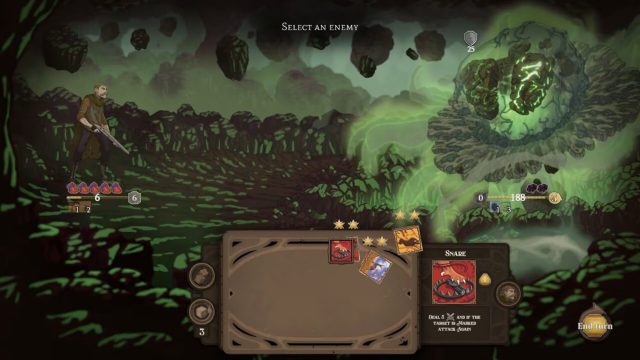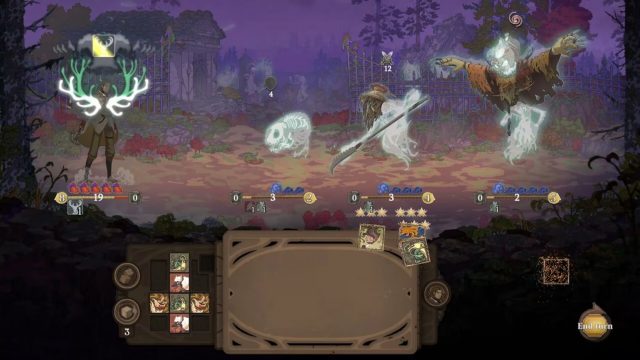Customizable dice to create powerful combos; Great artwork
Lack of control over dice; Unlocking new things takes too long; Combat too swingy: too easy to too difficult in matter of turns
Welcome to another Backlog Review, where we take a look at an older game that fans might have sitting waiting to be played or are still considering giving a purchase. This time we’re looking at Tamarak Trail.
Tamarak Trail is another new take on the deckbuilding roguelike genre popularized by the success of games like Slay the Spire, but it’s lacking some of the features that would keep you coming back for more. It begins with a cutscene that depicts some sort of meteor that lands in a forest and seemingly corrupts the life around it, creating werewolves and birds with shotguns and other monstrosities. The narrative here leaves much to be desired as there is no explanation as to what is happening and why we are sent out to fight these things, but the same could be said of other games within this genre. Ultimately, the focus is on the gameplay.
The tutorial to get things off the ground left me with many questions, as the inputs to progress the dialogue also triggered in-game actions while simultaneously skipping the next line of dialogue. With no in-game glossary or descriptions of abilities, or even a way to reset the tutorial, it became a game of trial and error to figure out how things worked. This was a struggle as some of the text (in the rare cases there even was a description of something) was quite small.
The gameplay in Tamarak Trail is an interesting take on the genre, as it trades in cards for customizable dice instead. At the start of each run you’re given two dice with generic attack and defense abilities covering the sides. You slot abilities into where you want them to go on the dice, which is important because where an ability is slotted can turn and flip that die to another side, which in turn might allow you to get the roll that you’re looking for. There are also abilities that become stronger when your dice bounce into each other while rolling them. However, when your dice bounce, each ability becomes more costly to use, and this is where the system starts to fall apart.
The resource you use is called resolve and it acts as a pool for you to activate your dice abilities. It also acts as a sort of health buffer for your character—once it’s depleted, you start losing hearts upon taking damage. So when your dice inevitably do bounce into each other, you are spending more of your resolve to use your abilities, most of which might gain zero benefit while keeping the increased cost. I’ve come to the conclusion that this just seems like a half baked design choice.
Resolve does regenerate, but its only five per turn by default and not activating an ability only gives you one more for the next turn. Considering that you are only using two dice and only able to activate two of those abilities at a time without flipping the dice, it can be a risky gamble when you’re facing a lot of incoming damage, especially taking into consideration the increased cost for sometimes zero benefit, as mentioned.
This brings up another issue with the system, which is that the dice rolling by its nature is inconsistent. This means you may roll only defensive abilities when the enemies aren’t attacking or you’re rolling no defense at all when the enemies have an all-out assault staged. Other games using dice as a main mechanic have a healthy supply of ways to modify or re-roll in order to give a good (but not complete) amount of control over your dice, which works really well. In Tamarak Trail, by contrast, you get three re-rolls for the entire run by default. When using reroll on all your unspent dice it could very likely put you in the same predicament you were just in. This results in very little you can do to regain re-rolls, and even then it’s an opportunity cost of not choosing something that may be more beneficial.
Games like Slay the Spire often have consumables to give a temporary boost, or artifacts that can give build-altering passive benefits. Tamarak Trail, meanwhile, doesn’t offer consumables, and its passive bonuses are called cores and also have their own quirk. Cores can be slotted into individual dice and affect that die only. The choices for these cores are quite limited and unimaginative, ranging from one extra damage to attacks, to some extra defense, and not much else. Perhaps the combat system is the way that it is because of how inconsistent the dice can be, so the developers thought that a resource/health system would work as the player is balancing using it to deal damage while holding back enough to survive attacks. Unfortunately, with limited control over the dice, the player isn’t really left with many options to plan a strategy aside from where to place the abilities on the dice before the battle starts.
Once your run has ended in failure or success (more often the latter as the game can be quite difficult and unrelenting with little to control your dice with) you unlock new abilities to be utilized in future runs. During each run you can earn currency that allows you to unlock more permanent upgrades or characters, but the cost is quite high considering you only get one of this currency when defeating the first boss/miniboss and these upgrades can cost five to ten each. This can result in speedruns to kill that first boss over and over just to unlock and see something new.
That isn’t to say everything is lackluster here, as the artwork is fantastic and the music and sound are also quite solid, but it isn’t enough to carry Tamarak Trail when so much could be improved upon elsewhere.
Nintendojo was provided a copy of this game for review by a third party, though that does not affect our recommendation. For every review, Nintendojo uses a standard criteria.




 ShareThis
ShareThis







